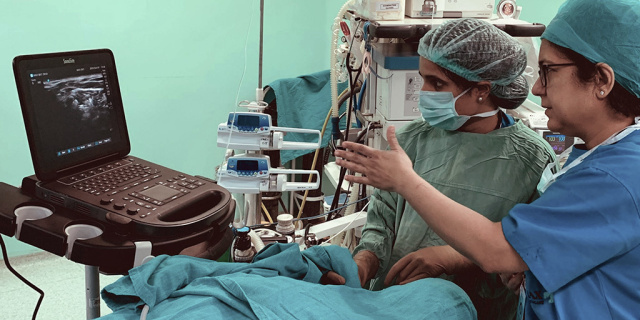

Dr. Raj Tobin, Director & Head of the Department of Anesthesiology at Max Super Specialty Hospital in Saket, New Delhi has 28 years of experience in anesthesiology. We interviewed Dr. Tobin to learn about the various clinical applications and the benefits of using point-of-care ultrasound (POCUS) in her routine practice.
How long you have been using ultrasound in your practice?
My first introduction to ultrasound technology was in 2006 when I attended a regional anesthesia workshop in New Delhi conducted by Dr. Manoj Karmakar from Chinese University, Hong Kong. It was an amazing experience to learn ultrasound guided procedures. Thereafter, I attended a couple of more workshops on ultrasound-guided regional anesthesia (USGRA) conducted by the European Society of Regional Anesthesia. I was thrilled and delighted when our institution procured a Sonosite ultrasound machine exclusively for our anesthesia department in 2009.
How do you find POCUS useful or different than other imaging modalities?
Firstly, there is no radiation hazard posed by the POCUS system, so there is no requirement for bulky personnel protection equipment and monitoring for radiation. Additionally, Sonosite ultrasound systems offers excellent return of investment. They are very cost-effective to procure, very sturdy machines with minimal maintenance, and very easy to move between operating rooms and intensive care units. For performing ultrasound-guided procedures, an anesthesiologist can single-handedly perform the task, as compared to a fluoroscopy where techncian assistance is required.
Which ultrasound system are you currently using and for which clinical applications?
Our journey began with Sonosite’s MicroMaxx ultrasound system with a linear and a curvilinear probe. Then we upgraded to the M-Turbo. Currently, we are also using an Edge II machine, which has excellent image quality. We can store multiple images and video clips in the machine and transfer them out easily for teaching purposes. Nowadays, all the invasive lines in our department are placed under sono-guidance, and we utilize the hockey stick probe for arterial lines and pediatric central line access. High-frequency linear probes are used mostly for regional nerve blocks. Recently, we procured a curvilinear C35x probe for our Edge II system. Because of its small foot print, we find this probe absolutely wonderful for quadratus lumborum blocks and spinal sonography in difficult patients.
Can you give us any case studies where POCUS was helpful in making the right decision?
There have been many such cases. We have diagnosed aberrant vessels while placing an interscalene catheter and given successful blocks in morbidly obese patients. This ultrasound technology is a boon for patients with difficult spines. We also use POCUS for measurements of the optic nerve sheath diameter as a surrogate of ICP in patients undergoing robotic pelvic surgery, for all central vein cannulations so that unnecessary attempts and patient discomfort can be avoided, for assessment of volume status in patients on dialysis, for tapping pleural effusion in ICU patients, and for diagnosing pneumothorax. In addition, we use ultrasound for confirming placement of double lumen tubes in thoracic surgeries.
Tell us about some of your academic endeavors and upcoming plans for promoting ultrasound education in your area of expertise.
I believe that “In teaching, you learn every day.” Since 2013, we have conducted annual workshops in ultrasound-guided procedures, and sometimes twice a year, to familiarize the anesthesiologists, intensivists, and pain management physicians with the use of sonography in perioperative procedures. We took the initiative to conduct cadaver workshops so that the clinicians may more easily correlate anatomy with sono-anatomy.
I must take this opportunity to thank FUJIFILM Sonosite for their tremendous amount of support in our academic ventures. Under the umbrella of “Interventional Perioperative Sonography Association (IPSA),” we have been conducting “Indian Diploma in Regional Anesthesia” courses under the aegis of “Indian College of Anesthesiologists” since 2014. Apart from the young anesthesiologists, what keeps me going is that sonography has generated a lot of interest in senior anesthesiologists, too. There is this tremendous zeal among them to learn and adopt POCUS for delivering better patient care.
